I bought this because I liked the look and feel of it, and it was cheap. It cost me around $27, after tax, and since I bought it at a woodworking show I didn't have to pay shipping. Hey, why not... at the worst, I've got some nice rosewood to use for something, right?
What is it?
First things first: What IS this thing? Is it a shoulder plane? A rabbet plane? Something else entirely? I'll be honest, I don't really know. I tend to think of it as a shoulder plane, but my understanding is that shoulder planes are supposed to be low angle to improve their ability to cut cross-grain. This is NOT a low angle plane, and while it's not completely terrible cross-grain, it's not very good either. But I'll get to that. Since the Shelter Institute doesn't actually show this on their site, here's what it looks like. Maybe some kind reader can tell me what this is...

Sorry about the glare.
What's the construction like?
I'll point out one thing right away: this is a wooden plane. There's no adjusting screws. There's no fence, or depth gauge, or anything like that. It's a block of wood with a hole in it, and a wedge to hold the blade in place.
The person at the booth claimed the cutter was of Japanese manufacture, and was one of their laminated blades (hard steel and soft welded together, and set up so the hard steel provides the cutting edge. It may well be, but I can't prove it is or isn't. For the sake of argument, I'll assume it is. It kind of looks like it, anyway. It didn't come out of the package razor sharp, but it did have a reasonable edge. A few minutes with an oilstone and a strop and it took some hair off my arm just fine.
The body is rosewood, or something remarkably like it, and feels pretty nice. The sole is smooth and flat, which is a bonus. Here's where I mention probably the only real problem I found: the sole isn't square to the sides. It's off just about exactly one degree, according to my angle gauge, which translates to something like 2 thousandths of an inch height difference across the width of the plane. I'm going to say that's good enough for me, but it may not be good enough for you. You'll have to decide. And, since these are wood, the next one may be perfect, or may be off by two or three degrees. You pays your money, you takes your chances.
The cutter fits cleanly in the body, and the wedge fits well. Not much more to say, here... some indents to make it easier to grip would have been nice, but it's not bad to hold as is.
How does it work?
Quite well, once I got the hang of adjusting it! Setting a wooden plane is a skill in and of itself, and one I didn't have before this. But, since pictures speak louder than words, here are some pictures of experiments with pine.
1) A nice curl, with a heavy cut. I didn't bother to measure it, but it's about as heavy as I've done with my Stanley #5, so I'm satisfied.
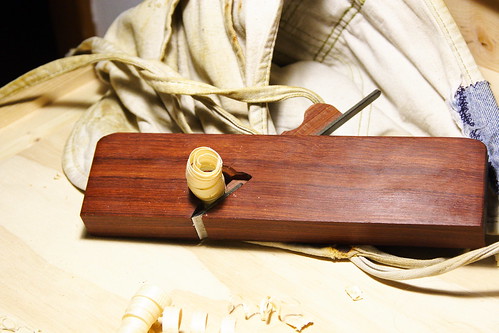
2) Heavy to fine cuts.
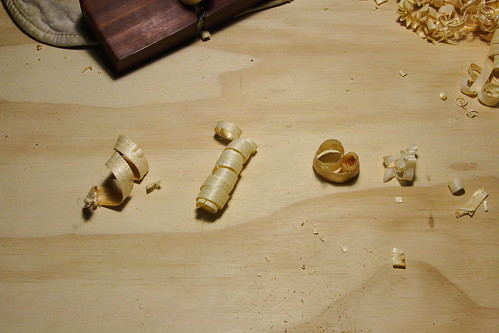
3) The two finest, closer up. I didn't quite get down to see-through, but it was close.
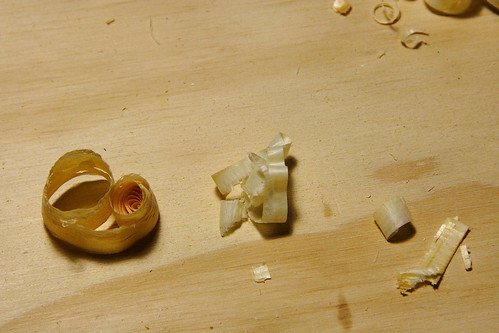
4) Cross gain shavings: not as fine as the ones with the grain!
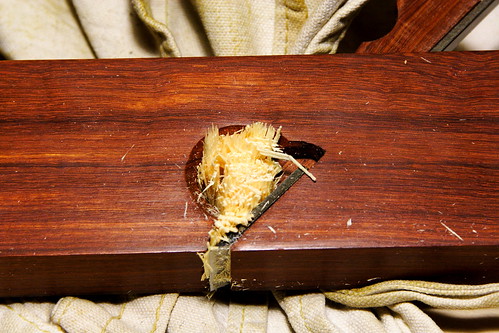
5) The wood -- with the grain and across it, after planing. Cutting cross-grain, I cut a guide with a hand-saw first, then followed that with the plane. The edge it left was terrible when I let it work on its own.
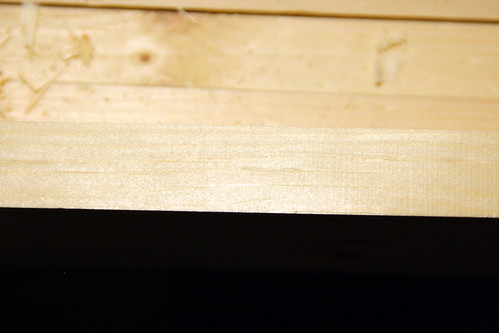
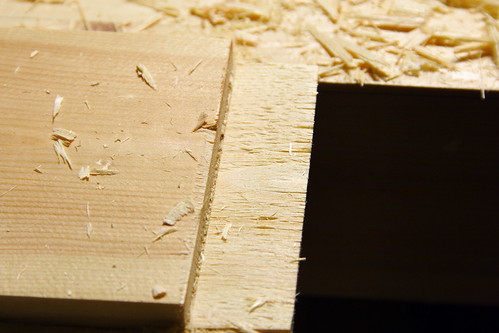
There was one design issue that showed up while I was testing. If you're not careful, the opening around the blade tends to fill up with shavings. If it gets packed enough, it can actually loosen the wedge, which is a problem!
UPDATE: I've been able to alleviate this somewhat by shaving the wedge down until it's angled to one side. It's still not perfect, but it takes longer to clog now.
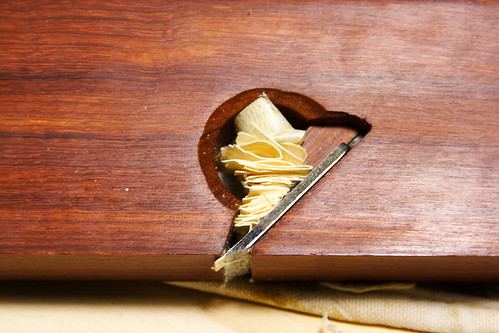
Final Thoughts
Overall, it works well. It leaves a clean surface when cutting with the grain, and it's light and easy enough to set up that I can see it having value for cleaning up a rabbet, say. I'll probably stick with my Miller's Falls 85 for most rabbet work, and almost all cross-grain (the nicker makes that a lot easier). In the end, it's light, cheap, attractive, and reasonably effective. Setting the depth is getting easier, so I can see a time when I don't have to think about that, I can just do it.
Would I do it again?
That's a hard question with this. For me, it's a tool in search of a job. It doesn't do the job I was hoping for, that of an actual shoulder plane, and I don't really need another rabbet plane. If I didn't have the MF 85, yes. It's absolutely a reasonable choice for cutting rabbets with the grain, and it can be made to work, more or less, for cutting across the grain. But since I DO have the 85.... I'm not sure. The thing cost $27, which isn't much, and it gives me one more option if I have a job to do. That might be worth it. It might not.
Either way, it's a decent tool, and some more practice and sharpening will probably leave me a lot happier with it.
UPDATE: For whatever reason, I've been using this more recently. I still quite like it, and if you need a straight rabbet plane, this is a good choice. I've now used it in pine, poplar, and red oak, and it works well in all three. In fact, I cut all the rabbets on a small oak box (around 3x3x10) with just this, and it worked beautifully. For parts that small, this is much easier than trying to use a metal rabbet plane with a fence. If I had no rabbet plane, and one of these came along for a price like I paid, I'd snap it up. It's a good choice, and has held up well.
No comments:
Post a Comment